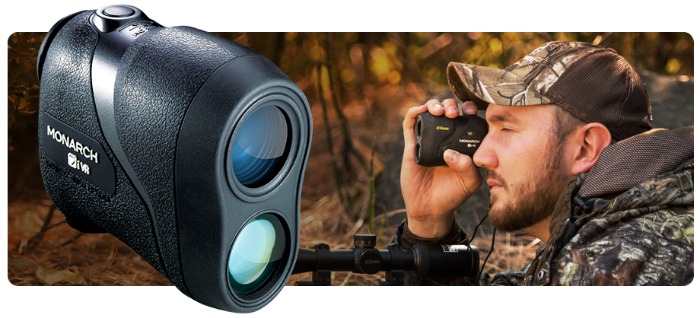|
Nikon Monarch 7i VR Laser Rangefinder  Sunset today in Plainfield, Illinois was 5:38 PM, with evening civil twilight from 5:37 - 6:05 PM. Civil twilight is often the end of legal hunting hours and when the apparent brightness of optics matters most. It is the end of civil twilight when I conduct low light optic comparisons. The exit pupil of the 6x Nikon Monarch 7i VR is 3.5mm, smaller than the brighter (in low light) Vortex Ranger 1500's 3.66mm. The Leupold unit shares the same basic monocular spec and resultant exit pupil. Tested side by side, a very slight edge in brightness goes to the Vortex over the Leupold, with the Nikon dimmer than either. This Monarch clearly does not provide as bright an image as the Leupold, Vortex and Leica rangefinders compared alongside it. For end of the legal hunting hours use, or for night hunting of coyotes and hogs, this probably isn't the rangefinder that will satisfy you. However, the Nikon has a big lead in several other categories of performance. It is easy to grip and use with one hand. The Mode button is on the left side of the unit, while the On button is conveniently located on top, over the ocular, where your index finger naturally falls. The eyepiece turns to focus to your eye and comes with a rubber ring to protect glasses from scratching. The field of view is clear and the multi-coated lenses do a good job suppressing flare. The measurement accuracy is stated to be +/-0.5 yard at distances less than 700 yards and +/- 1 yard between 700 and 1000 yards. The Nikon has image stabilization when activated, an industry first, as far as I know. The Monarch 7i VR makes a bit of noise when activated, apparently due to the image stabilization system. Nikon says this unit has an optical VR (Vibration Reduction) system, designed to reduce vibrations of the image in the viewfinder caused by hand movements (by approximately 80%)." While I have no easy way to determine a percentage, it clearly does work and it works very effectively. Unlike many rangefinders that use a bright red or reddish orange illuminated LED reticle, the Nikon uses a black LCD. Many LED reticles do not automatically adjust for ambient light, so they can blow your eyes out if you do not manually dim them for lower light conditions. Leica rangefinders, even my older LRF 900, auto-dims the LED reticle for you. The Sig Kilo 2000 units do, as well. Specifications
This Nikon comes in at about $350 or so discount retail price, a bit less than similar rangefinders in this category that lack image stabilization. Whether this is the rangefinder for you depends on how much you value the image stabilization, how it fits in your hand and the increased capability of its inclinometer, which is plus/minus 89 degrees. Many rangefinders with "true ballistic range" or "shoot as if" ranges based on incline limit-out at 60 degrees. |